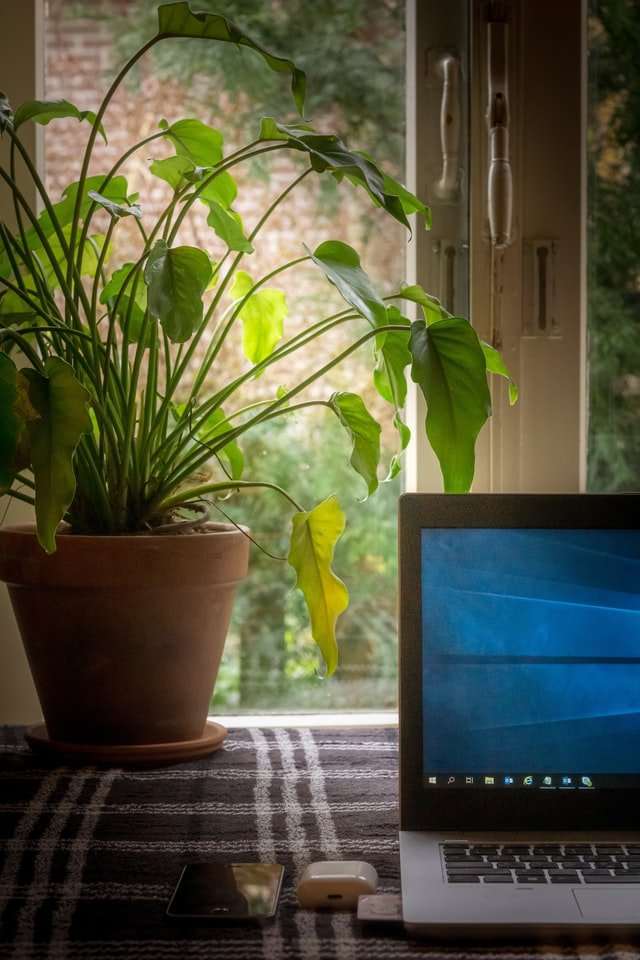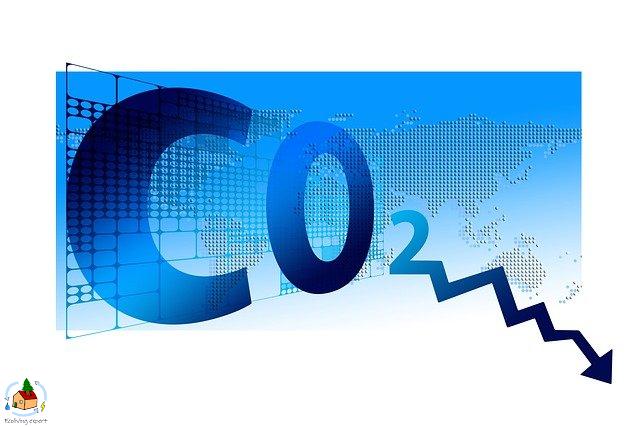In indoor areas with elevated CO2 levels, air purifiers can remove up to 12% of the CO2 in the air before the filter is saturated. For the removal of CO2, a gas-removal filter such as an activated carbon or zeolite filter is required.
Because high levels of CO2 can be harmful to our health, and rising global CO2 levels are causing climate change, the removal of CO2 from the air is a hot topic. Unfortunately, CO2 removal is not very easy to do artificially. Of course, plants specialize in CO2 removal, but we would need a lot of plants to really make a difference.
An air purifier is very effective at improving indoor air quality. Unfortunately, these purifiers are mostly designed to remove airborne particles like dust and pollen. Without a specialized filter, they cannot remove gasses from the air.
Removing CO2 with an air purifier: activated carbon and zeolite filters
Most air purifiers are designed to remove harmful particles from the air. To do this, they have one or more filters through which the air is blown. These filters work like a net, catching dust and pollen while letting the air go through.
However, this filtration does not remove gasses. Gasses are simply too small to be caught in any net, no matter how small the holes.
Luckily, there are several options for removing CO2 and other gasses from the air. The following gas filters are available for air purifiers:
- activated carbon filters
- zeolite filters
Activated carbon filters are by far the most common among high-quality air purifiers designed to remove gasses such as odors or the smell of smoke.
But first, why do we want to remove CO2 from our air?

How much CO2 is harmful?
The air consists mainly of Nitrogen (78%) and Oxygen (21%). Carbon dioxide (CO2) is fourth with 0.04%, behind Argon (0.93%). So normally, CO2 is only present in very low quantities. However, due to a combination of poor ventilation and people breathing out CO2, indoor CO2 levels can become very high.
When CO2 levels are too high, they can have serious health effects ranging from minor complaints of drowsiness to oxygen deprivation in extreme scenarios. Therefore, it is wise to monitor CO2 levels and make sure ventilation is adequate.
- Normal (outdoor) levels of CO2 are around 400 parts per million (ppm). Meaning there are 400 CO2 particles for every million particles in the air. This is the same amount as the abovementioned 0.04%.
- Typical CO2 levels in indoor spaces that are in use and are being ventilated are between 400 and 1000 ppm. This does not have any negative effects.
- 1000 to 2000 ppm is exceptionally high and causes minor health effects such as drowsiness and complaints of poor air quality.
- 2000 – 5000 ppm is extremely high and very unlikely to occur. These levels of CO2 can cause headaches and increased heart rate.
I remember during my Environmental Sciences studies that it was particularly hard to concentrate during the Earth and Environment lectures. One day, the teacher brought an air quality monitor and it revealed that the CO2 levels during class increased fivefold. No wonder we were falling asleep!
If you want to read more about the effects of CO2 on our health and what levels are dangerous, I recommend reading my article: What are healthy indoor CO2 levels? (safe levels, health effects and what to do about them).
Activated carbon filters
Some air purifiers come with an extra filter called an activated carbon (AC) filter. This filter is specifically designed to remove gasses from the air.
Activated carbon filters are made from carbon, also known as charcoal. This material is very effective at removing gasses but is also commonly used in cosmetics.

Activated carbon makes molecules stick to its surface. This is called adsorption (the more commonly known absorption, written with a b instead of a d, works similar to a sponge). Adsorption (with a d), makes molecules stick to a surface. Therefore, the larger the surface area, the more molecules can be adsorbed.
Activated carbon is ‘activated’ with a form of treatment that increases the surface area of the carbon. A larger surface area means that more molecules can be removed. One gram of AC has a surface area of about 3,000 m2 (32,000 sq ft). Because of this, an activated carbon filter can take up a lot of tiny molecules, including gasses.
Zeolite filters
Zeolite filters work in much the same way as activated carbon. They have a very large surface area that adsorbs gas molecules to their surface, removing them from the air. These filters are made from zeolite stone that has similar properties as activated carbon.
Normally, activated carbon is better at removing gasses than zeolite. However, in the case of CO2 removal, zeolite performs a little better. Unfortunately, zeolite filters are quite rare as activated carbon is the norm among high-quality air purifiers.
If you are specifically looking for an air purifier that can help reduce CO2 levels. Consider purchasing a zeolite filter over an activated carbon filter.
What influences CO2 removal?
Activated carbon (AC) and zeolite filters both work in the same way. They are a porous material with a gigantic surface area on which many molecules can be adsorbed. These molecules pass by the filter and stick to the surface and pores of the AC of zeolite.
However, not every gas has an equal chance of sticking to the filter. For example, larger particles get stuck more easily.
There are several factors that influence how well a certain molecule sticks to an AC or zeolite filter:
- The type of compound: compounds with a high molecular weight stick more easily
- The concentration of the compound: when there are more molecules, they tend to more easily stick to the filter
- The temperature: activated carbon filters work better at lower temperatures
- Air pressure: at higher air pressure, filters work more effectively
- Humidity: with low air moisture, filters perform better
So how does this relate to CO2 removal?
Type of compound:
We are investigating CO2, carbon dioxide.
Concentration:
A higher concentration of CO2 will lead to a higher removal efficiency. This presumably works as follows: there is a larger chance that CO2 hits the filter instead of another compound since there is more CO2 floating around.
Temperature:
A lower temperature results in more CO2 capture. Unfortunately, we do not have that much control over the air temperature. It is, however, likely that turning on the air conditioner or cooling the filter in another way improves the performance of the filter.
Pressure:
We have no control over the air pressure. It is dependant on the weather and will always be approximately 1 bar (14.5 psi/10.000 pascal).
Humidity:
We have some control over the amount of moisture in the air when using a humidifier or dehumidifier. You can try to combine a dehumidifier with an AC filter to get the best performance. I presume that the activated carbon can more easily remove gases when water in gaseous form is not too abundant since it likes to adsorb water vapor as well.
How much CO2 can be removed by an air purifier?
I dug deep into several studies to find out how much CO2 can actually be removed. I found a study that looked at activated carbon and zeolite filters and their removal of CO2 from the air. The only downside to this study was that their CO2 levels were much higher than they will ever be in real life.
Normal CO2 levels are around 400 ppm (parts per million). This means CO2 takes up 0.04% of the total volume of the air. High levels of CO2 are considered above 1000 ppm (0.1%) and extremely high levels are around 5000 ppm (0.5%). The best study I could find used air with a CO2 level of 13.8% (138000 ppm).
CO2 removal study results
Most studies on CO2 uptake by activated carbon or other filters are designed to test the removal of extremely high CO2 concentrations (sometimes 100% CO2 gas) in industrial waste flows.
Luckily, one study tested activated carbon and zeolite filters on air with 13.8% CO2 (source). This study found that both activated carbon filters and zeolite filters are effective at removing CO2 from the air. However, the removal of CO2 was limited to the amount that the filter could take up before it was completely full.
For my calculations for the expected CO2 levels in occupied indoor areas, I assumed a room size of 330 cubic feet (the average living room size in the United States). In this way, I can calculate how much the CO2 level drops in this room when using an air purifier with an AC or zeolite filter.
Since activated carbon and zeolite perform very similarly, and filter size is much more relevant, the following table only shows the effectiveness of different filter sizes. Additionally, the table shows how long it takes for the filters to become saturated.
| CO2 removal | Parts per million (ppm) | Percentage of air | Removed by small filter (1.6 ounce/0.05kg) | Removed by medium filter (5.6 ounce/0.16kg) | Removed by large filter size (9.6 ounce/0.27kg) | Time untill filter saturation |
| Tested levels | 138000 | 13.8% | 0.03% | 0.09% | 0.16% | 30 – 40 minutes |
| Elevated levels | 2000 | 0.2% | 1.97% | 6.9% | 11.8% | 30 – 40 minutes |
The data in the table above for the tested levels are calculated based on the test results of the study I mentioned. The data for 2000 ppm are based on the same removal rates as the tested levels. This means they are likely too high because, as mentioned earlier, the concentration of CO2 determines how much can be taken up. When the concentration is much lower (2000 instead of 138000), CO2 uptake will be lower.
In fact, if the removal efficiency would remain the same regardless of CO2 level, an AC or zeolite filter would remove more CO2 than is actually present in the air. This is of course not the case.
So, unfortunately, there is no good data on how much CO2 can be removed. However, my calculations and the results from the study show that it cannot be more than 11.8%.
Something that can be done, however, is washing the filters for re-use.
Washing a filter for reuse
Since AC and zeolite filters do not get clogged with particles that can be washed off, cleaning with water or vacuuming does not help. However, exposing the filter to direct sunlight outdoors for 2 to 3 hours will help release adsorbed gasses (remember that they work better at low temperatures, so gasses are released when it gets warm).
This study found that the CO2 removal efficiency of the filters declined every time the filter was cleaned. The filter can therefore only be used about 4 times.
How to remove CO2 from indoor air without an air purifier
Air purifiers are not the most effective way of removing CO2 from the air. Let’s have a look at some other methods of CO2 removal.
Ventilation reduces indoor CO2 concentrations
Ventilation is key for removing CO2 and preventing a rise in CO2 levels. As mentioned at the beginning of this article, the outdoor air has a CO2 percentage of 0.04%. This is well within the healthy range of 0.025 to 0.1%. When you ventilate, you let out your poor indoor air and fresh outdoor air enters your home.
Most houses, especially old ones, have plenty of natural ventilation. However, if you own a relatively old house that has been renovated, chances are it got an extra layer of insulation. This is very good for keeping heating costs low and maintain a comfortable indoor temperature. However, the newly installed insulation material likely blocks some of the previously present means of natural ventilation.
Therefore, you need to make sure you are conscious of the need to open windows and doors in order to allow for air exchange between the in- and outdoor air.

Do houseplants help remove CO2?
Well, yes, houseplants do take up CO2 and provide oxygen. However, their effectiveness is unfortunately quite low, and you should never rely on plants over ventilation.
A study on the potential of houseplants to remove CO2 in an office concluded that in order to remove 10% of a person’s exhaled CO2, about 15 high-performing CO2 removing plants were needed. High performing in this case meant:
- very good health (proper management of plants)
- very high light conditions (five times higher than in an average office)
In normal conditions, however, it is likely that you will need about 100 plants to reduce CO2 levels. And then still only 10% of one person’s exhaled CO2 will be removed.
So if you are serious about your CO2 levels, make sure you properly ventilate. Consider plants for their plethora of other benefits such as improved happiness and well-being.
If you are interested in all the ins and outs about plants and indoor air quality you can read our article: Do house plants improve indoor air quality?
Monitoring air quality for a healthy indoor environment
An air quality monitor is a great tool to measure your indoor CO2 levels. With an air quality monitor, you are always aware of your surroundings and can respond to deteriorating air quality in time. An air quality monitor makes you feel safe and prepared.
If you are looking to purchase an air quality monitor it is wise to consider a device that measures more than just CO2 since there are many other factors influencing indoor air quality.
A Norwegian company called Airthings produces excellent air quality monitors. They are easy to operate (just wave your hand in front of the device) and send their data to an app on your phone.
Discount on Airthings air quality monitor
By using this link to the Airthings Wave Plus air quality monitor you will get a discount of about 10%!
The Airthings Wave Plus air quality monitor not only measures CO2 levels but also VOCs, humidity, temperature, air pressure, and radon.
How to keep indoor CO2 levels low without ventilating in poor outdoor air?
In general, outdoor air quality is much better than indoor air quality. Indoor air is normally 2 to 5 times worse than outdoors. However, sometimes, the outdoor air is exceptionally bad. For example during smog when the outdoor air is filled with a smokey fog (therefore the term smog). In this case, preventing ventilation and not letting in outdoor air is advised.
Although a smog contains dangerous levels of air pollutants, its CO2 levels are still the normal 0.04%.
Not ventilating will lead to a rise in indoor CO2 levels. Luckily, CO2 levels do not rise that quickly in your home. Therefore, you can wait on ventilating the house until the worst outdoor air has passed. If you are concerned about your indoor CO2 levels, or your air quality monitor shows elevated levels, you can open all indoor doors in order to circulate the air and lower CO2 concentrations within the building.
In small crowded places, however, CO2 levels can rise quickly and ventilation is needed to lower their levels. Your best option is to choose the best time to ventilate and let in some low-CO2 outdoor air.
The best time to ventilate is around 14:00 since traffic is at a low point while the sun creates warm air which rises and transports pollutants away from the city. Other suitable times are between 4 and 6 in the morning and between 10 and 1 in the evening/night.
There are some disadvantages of air purifiers that you should know. You can read all about them in my article: What are the disadvantages of air purifiers?
Conclusion
An activated carbon or zeolite filter is required for an air purifier to remove CO2 from the air. However, this filter can only remove about 10 to 12% of the total CO2, and only if their levels are exceptionally high such as 2000 ppm or higher.
Zeolite and AC filters can be cleaned for reuse by exposing them to direct sunlight for 2 to 3 hours. However, their effectiveness declines over time and they cannot be reused more than 4 times.
The most effective way of reducing indoor CO2 levels is to make sure ventilation is adequate. Ventilation should be done constantly for the best indoor air quality. If ventilation cannot be done constantly, the best times to ventilate are between 4 and 6 in the morning, around 2 during the day, and between 10 and 1 in the evening.

